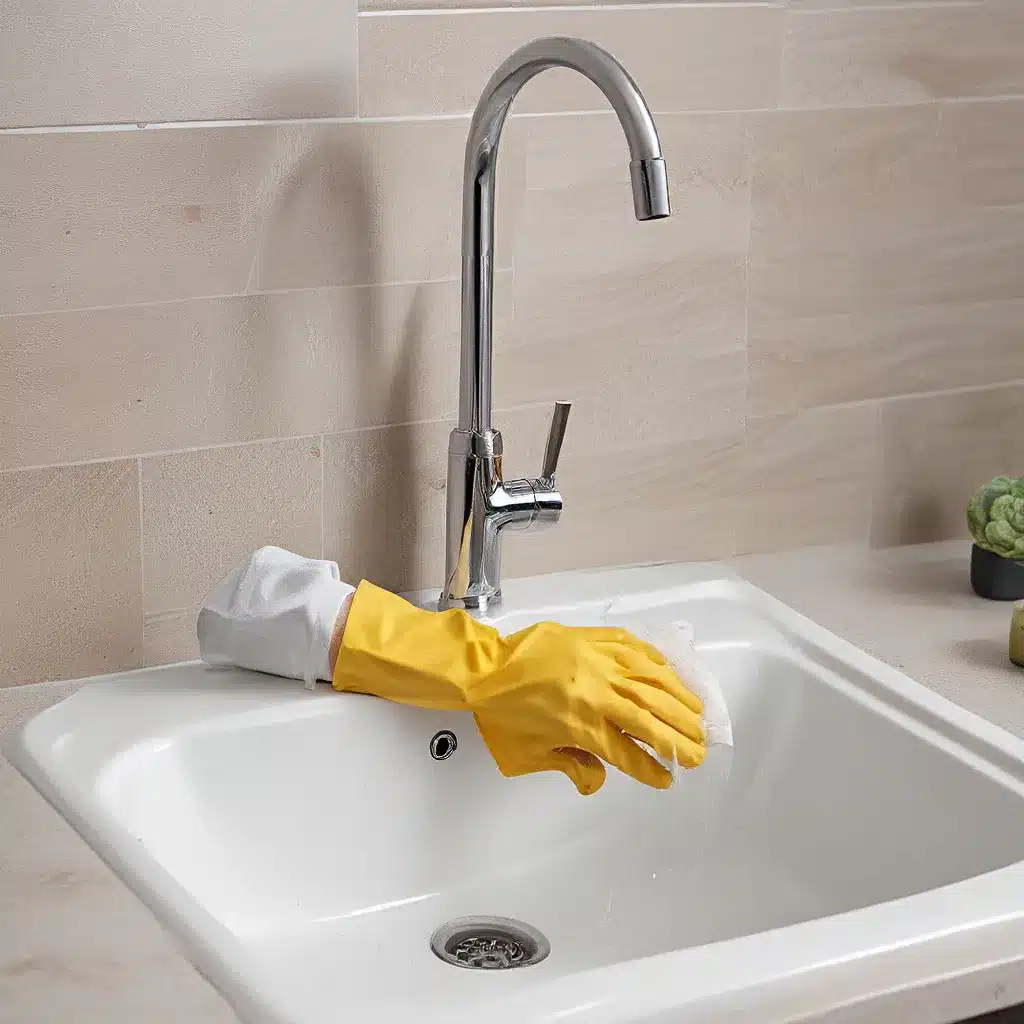Ah, the kitchen sink – the silent workhorse of our homes, quietly toiling away as we prepare meals, wash dishes, and tackle all manner of culinary tasks. But let’s be honest, when was the last time you gave that trusty sink a good cleaning? If you’re like most people, it’s probably been a while. And that’s a problem, because a dirty, neglected sink can harbor all sorts of nasty bacteria and grime that can put your health at risk.
The Importance of Proper Sink Maintenance
Think about it – your kitchen sink is a breeding ground for all kinds of icky stuff. From food particles and grease to soap scum and hard water buildup, it’s a veritable petri dish of potential illness-causing microbes. And if you’re not diligently cleaning and disinfecting that sink on a regular basis, you’re essentially inviting those germs to take up permanent residence in your kitchen.
But don’t worry, I’ve got your back! In this comprehensive guide, I’m going to share some tried-and-true techniques for keeping your sink sparkling clean and bacteria-free. From effective drain cleaning methods to the proper way to disinfect your sink, you’ll learn everything you need to know to maintain a sanitized and hygienic kitchen environment.
Tackling Stubborn Drain Clogs
Let’s start with one of the most common sink issues – clogged drains. Those pesky blockages can not only cause water to back up and overflow, but they also create the perfect breeding ground for all sorts of nasty bacteria.
Pouring bleach or boiling water down the drain may seem like a quick fix, but these methods are actually not very effective in the long run. Instead, try using a baking soda and vinegar solution. Simply pour a cup of baking soda down the drain, followed by a cup of white vinegar. Let the mixture fizz and bubble for a few minutes, then flush it with hot water. This natural, non-toxic approach can help break down and dissolve even the toughest clogs.
Another great option is to use a drain snake or plumber’s snake. These handy tools are designed to physically break up and remove trapped debris, making them particularly effective for stubborn blockages. Just be sure to follow the instructions carefully and wear gloves to avoid any unpleasant encounters with the gunk you’re removing.
Disinfecting Your Sink
Once you’ve tackled the clog, it’s time to focus on disinfecting the sink itself. Remember, even if the water is draining properly, your sink can still be a breeding ground for all sorts of nasty bacteria and germs. That’s why it’s important to clean and disinfect it on a regular basis.
The three-sink method is a tried-and-true technique used in commercial kitchens to ensure that dishes and utensils are properly cleaned and sanitized. And guess what? You can use the same approach to keep your home sink sparkling clean.
Here’s how it works:
-
Wash: Fill the first sink with hot water and a small amount of dish soap. Use a scrub brush or sponge to thoroughly clean the sink basin, walls, and any removable fixtures.
-
Rinse: In the second sink, rinse the sink thoroughly with clean, hot water to remove any remaining soap residue.
-
Sanitize: For the final step, fill the third sink with a sanitizing solution, like a diluted bleach or quaternary ammonium compound. Let the sink soak for at least a minute to ensure proper disinfection.
After completing these three steps, make sure to air dry the sink rather than using a towel, which can actually spread more germs. And don’t forget to clean and sanitize the drainboard and any other surfaces around the sink as well.
Maintaining a Healthy Sink
Of course, keeping your sink clean and disinfected isn’t a one-and-done task. It’s something you’ll need to do on a regular basis to prevent the buildup of grime and bacteria. Here are a few tips to help you stay on top of sink maintenance:
- Wipe down the sink daily: A quick wipe-down with a damp cloth or paper towel can go a long way in removing any fresh spills or residue.
- Deep clean weekly: Set aside time once a week to thoroughly scrub and disinfect the sink using the three-sink method.
- Check for clogs regularly: Don’t wait until the water is backing up to address a clogged drain. Proactively use a drain snake or baking soda and vinegar solution to keep things flowing smoothly.
- Avoid harsh chemicals: While bleach and other harsh cleaners may seem effective, they can actually damage your sink over time and release toxic fumes. Stick to natural, eco-friendly alternatives whenever possible.
By following these simple steps, you can keep your kitchen sink in tip-top shape and ensure that it’s a safe, hygienic environment for all your culinary adventures. And don’t forget to incorporate a regular sink cleaning routine into your overall cleaning schedule – your health (and your taste buds) will thank you!
If you’re looking for a reliable cleaning service to handle all your sink-related needs, be sure to check out Adam Cleaning. Their team of experienced professionals can tackle even the toughest sink challenges, leaving your kitchen sparkling clean and germ-free. So why not take the hassle out of sink maintenance and let the experts handle it?







